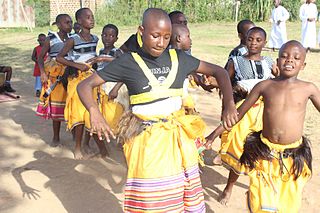
Culture of Uganda is made up of a diverse range of ethnic groups. Lake Kyoga forms the northern boundary for the Bantu-speaking people, who dominate much of East, Central, and Southern Africa. In Uganda, they include the Baganda and several other tribes

The Gisu people, or Bamasaba people of Elgon, are a Bantu tribe and Bantu-speaking ethnic group of the Masaba people in eastern Uganda, closely related to the Bukusu people of Kenya. Bamasaba live mainly in the Mbale District of Uganda on the slopes of Mount Elgon. The Bagisu are estimated to be about 1,646,904 people making up 4.9% of the total population according to the 2014 National Census of Uganda.

The Nyero rock paintings are located in eastern Uganda in Kumi District, 8 km (5.0 mi) west of Kumi town, about 250 km (155.3 mi) from the capital city Kampala. The Nyero rock paintings are among the most important rock art in Uganda.

The Uganda Museum is located in Kampala, Uganda. It displays and exhibits ethnological, natural-historical and traditional life collections of Uganda's cultural heritage. It was founded in 1908, after Governor George Wilson called for "all articles of interest" on Uganda to be procured. Among the collections in the Uganda Museum are playable musical instruments, hunting equipment, weaponry, archaeology and entomology.

The Hornbill Festival is an annual festival celebrated from 1 to 10 of December in the Northeastern Indian state of Nagaland. The festival represents all ethnic groups of Nagaland for which it is also called the Festival of Festivals.

The Tooro people, also known as Batooro or Toro people are a Bantu ethnic group, native to the Tooro Kingdom, a subnational constitutional monarchy within Uganda.

Milege Afrojazz Band, commonly known as Milege, is a world music band from Uganda, made up of young talented musicians from Uganda whose enthusiasm is derived from the diverse cultural music traditions of the different tribes of Uganda into which they fuse contemporary elements to express the likeness of Uganda's people in a more current context. As of 2015 Milege's members are; guitarist Manana F. Birabi, vocalist Joanita Katushabe, lead vocalist Gloria Akugizibwe, bassist Paul Owembabazi and violinist Alison Nadunga as a seasoned member.

Sindhi Cultural Day is a popular Sindhi cultural festival. It is celebrated with traditional enthusiasm to highlight the centuries-old rich culture of Sindh. The day is celebrated each year in the first week of December on the Sunday. It's widely celebrated all over Sindh, and amongst the Sindhi diaspora population around the world. Sindhis celebrate this day to demonstrate the peaceful identity of Sindhi culture and acquire the attention of the world towards their rich heritage.

Bwola, also known as Acholi bwola, is a traditional dance that originates from the Acholi people in Northern Uganda. It is reserved for special occasions and performances in front of royalty, including kings and chiefs. This dance is often showcased during the installation of new chiefs or at various royal functions.

Ekizino, also knowns Kizino, is a traditional social dance originating from the Bakiga people in Kigezi region of southwestern Uganda. It is derived from the hilly terrains of the region, where farmers engage in vigorous jumping to warm up and stretch their muscles after a hard day's work.

Ugandan folklore includes traditional folktales and other folklore from the African country of Uganda. The convey meaning and experiences from generation to generation. Traditionally, folktales instilled discipline and good behaviour that shaped societal beliefs and norms within Ugandan society.

Orunyege-Ntogoro is a traditional dance from the Bunyoro and Tooro kingdoms in western Uganda. It is a courtship dance that involves the use of rattles (ebinyege) and rings (entogoro) to produce rhythmic sounds and movements. The dance is performed by young men and women who seek to attract and impress potential partners for marriage.

Bakisimba dance (Baakisiimba) also known as Nankasa or Muwogola is a traditional dance form originating from the Baganda people of Buganda Kingdom in Central Uganda. It is believed to have originated from the movements of a drunken King Ssuuna of Buganda Kingdom. The dance was initially performed in the Buganda Royal Court in ancient times an it holds significant cultural and social importance within the community and is often performed during tribal ceremonies, celebrations, and festive occasions.
Kadodi dance is a traditional dance performed by the Bamasaba people, also known as the Bagisu or the Gishu, who live in the eastern part of Uganda and the western part of Kenya. Kadodi dance is mainly associated with the Imbalu the male circumcision ceremony that marks the transition from boyhood to manhood among the Bamasaba. Kadodi dance is also performed at other occasions, such as weddings, festivals, and cultural events.

Naleyo or Naleyo Dance is a traditional dance performed by the Karamajong people of North Eastern Uganda. It is a wooing dance performed in two lines with the women on one line and the men on the other line. The dance is characterized by the way the men and women jump high while facing each other, making it an interesting spectacle to watch.

Akogo dance is a traditional dance form of the Teso people of Eastern Uganda. This cultural expression is performed by both men and women, who gracefully move their bodies in synchrony with the rhythmic beats of the akogo, a percussion instrument crafted from bamboo tubes of varying lengths. The Dance is believed to have been performed by the Teso people for centuries and has evolved over time and has been influenced by other dance forms from neighboring regions.

Amaggunju is a traditional folk dance of the Baganda, who represent the largest ethnic community in Uganda. This royal dance is performed during important occasions such as coronations, weddings, and other cultural events. Notable features of the dance are its distinct rhythmic drumming and energetic movements, executed by both male and female performers.

So (Tepeth) are a tribe living in the mountain ranges of mountain Moroto in the northeast part of Uganda and North western Kenya in the Turkana region. Traditionally, the So (Tepeth) were hunters and fruit gatherers, the decline in wild animals in the region made them resort to agriculture for sustainable living between 1970 and 1980. Tepeth are believed as original occupants of Karamoja plains unfortunately the current settlers (Karamojong people) pushed the Tepeth up on the mountain.

Calabash is a traditional plant locally grown in many parts of Uganda. Its a non-food plant that produces several fruits of different sizes. The biological name of this plant is Lagenaria siceraria. Once harvested, its left to dry and is mainly used for traditional purpurses like dancing during traditional weddings, crafted as musical instruments by some tribes in their traditional dances for example the Bigwala, Baganda, Acholi, preserving milk, harvesting milk cream, and also used by traditional healers. Calabash is a symbolic cultural item that many Ugandan tribes use for different purposes.

The Gulewamkulu Traditional Dance is a traditional dance performed by the Chewa people of Malawi, and Zambia. Its history dates back to the 17th century, when it was performed by the Nyau societies, secret fraternal organizations that played a significant role in the social and political lives of the Chewa people. The Chewa ancestors started the dance to talk to the dead's souls, their predecessors and gods.





















